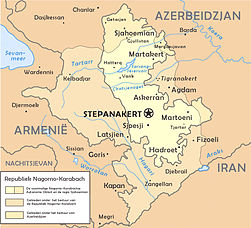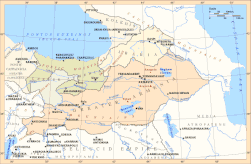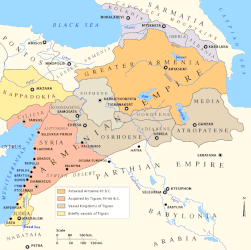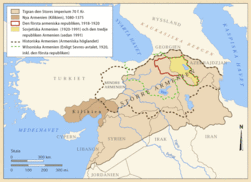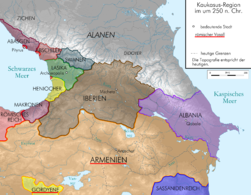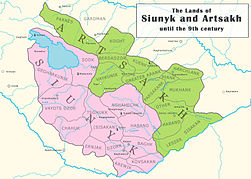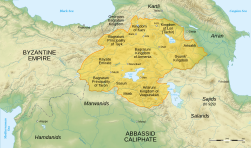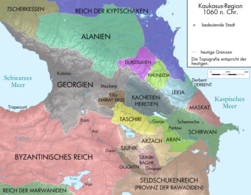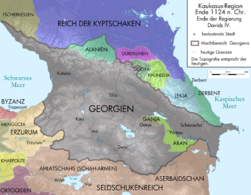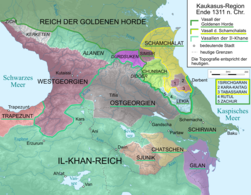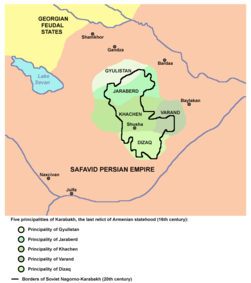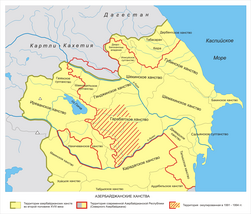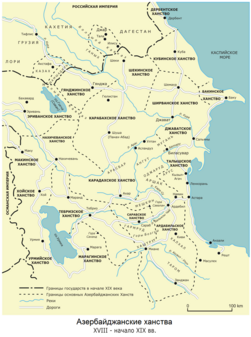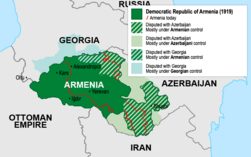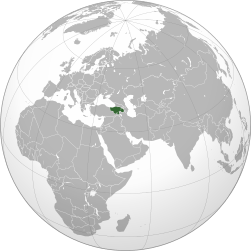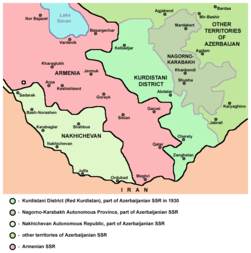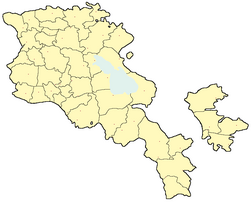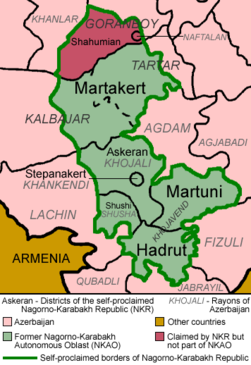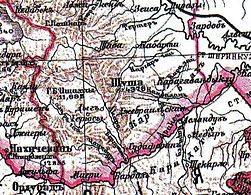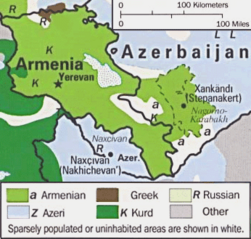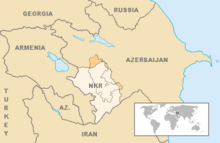| Հայերեն
|
Լեռնային Ղարաբաղ - Արցախ
Լեռնային Ղարաբաղը կամ Արցախը[1] անկախ, ինքնիշխան և իրավական պետություն է Անդրկովկասում[2]։ Արևմուտքից սահմանակցում է Հայաստանի Հանրապետությանը, հարավից՝ Իրանին, իսկ արևելքից և հյուսիսից՝ Ադրբեջանին։ Մայրաքաղաքը Ստեփանակերտն է։ Մշակութային կենտրոնը Շուշի բերդաքաղաքն է։
Լեռնային Ղարաբաղը պատմականորեն կազմում է Մեծ Հայքի Արցախ նահանգը։ Իր աշխարհագրական և քաղաքական դիրքով Արցախը կարևոր դեր է խաղացել Հայոց պատմության մեջ։ Հայ մեծանուն պատմաբան Լեոն Արցախը համեմատել է «հսկայական միջնաբերդի» հետ, առանց որի «անհնար է երևակայել Հայաստանի սրտի, այն է՝ Արարատյան երկրի պաշտպանությունը»[3]։
Այժմ Արցախը կայացել է որպես երկրորդ հայկական պետություն։ Այդպիսով ներկայիս Հայաստանը բաղկացած է Հայաստանի Հանրապետությունից (ՀՀ) և Լեռնային Ղարաբաղի Հանրապետությունից (ԼՂՀ)։
|
| English
|
Artsakh - Republic of Artsakh
The Republic of Artsakh or Artsakh Republic (Արցախի Հանրապետություն Arts'akhi Hanrapetut’yun)[4] was a breakaway state located in the South Caucasus region. It controlled most of the territory of the former Nagorno-Karabakh Autonomous Oblast, as well as seven Azerbaijani districts surrounding it.[5]
The predominantly Armenian-populated region of Nagorno-Karabakh became disputed between Armenia and Azerbaijan when both countries gained independence from the Russian Empire in 1918. After the Soviet Union established control over the area, in 1923 it formed the Nagorno-Karabakh Autonomous Oblast (NKAO) within the Azerbaijan SSR. In the final years of the Soviet Union, the region re-emerged as a source of dispute between Armenia and Azerbaijan, culminating in a large ethnic conflict and, eventually, in the Nagorno-Karabakh War that was fought from 1991 to 1994.
On December 10, 1991, as the Soviet Union was dissolving, a referendum held in the NKAO and in the neighboring Shahumyan region resulted in a declaration of independence from Azerbaijan as the Nagorno-Karabakh Republic. The country remains unrecognized by any UN member state, including Armenia. Only Abkhazia, South Ossetia, and Transnistria, all of which are non-UN member states, recognize Artsakh.
From the ceasefire in 1994 till the 2020 Nagorno-Karabakh war, most of Nagorno-Karabakh and several regions of Azerbaijan around it were under joint Armenian and Artsakh military control. Representatives of the governments of Armenia and Azerbaijan have held peace talks mediated by the OSCE Minsk Group. The areas surrounding Nagorno-Karabakh and parts of the NKAO, especially in the south (Hadrut, Tugh, Shusha, etc.) came under Azerbaijani control during and/or after the 2020 war. After blockading the republic for over 9 months, Azerbaijan began a military invasion in September 2023, forcing the entire Armenian population to flee.
|


